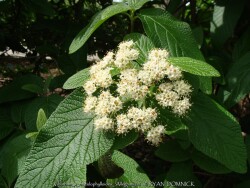
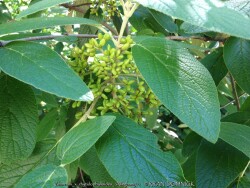
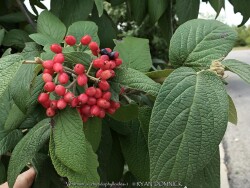
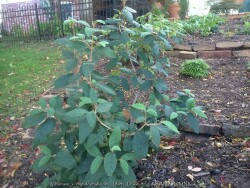

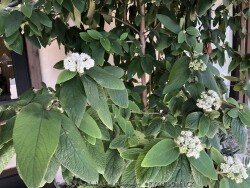
Plant Min Zone: 5a
Plant Max Zone: 8a
Sunlight: Full Sun, Part Sun, Shade
Water / Rainfall: Low, Average
Soil Quality: Poor, Average, Rich
Bloom Season: Early Summer, Summer
Flower Color: Cream
Berry / Fruit Color: Green, Red, Black
Spring Foliage Color: Green, Light Green
Summer Foliage Color: Green, Light Green
Fall Foliage Color: Green, Purplish Green
Evergreen Foliage: Some
Winter Interest: Yes
Scented Flowers: No
Drought Tolerance: Medium, High
Wet-Feet Tolerance: Low, Medium
Humidity Tolerance: Medium, High
Wind Tolerance: Medium
Poor Soil Tolerance: Clay Soils, Rocky Soils, Sandy Soils, Alkaline Soils (high PH)
Height: 5' - 10'
Width: 5' - 8'
Growth Rate: Medium, Fast
Service Life: Extremely long: over 20 years
Maintenance Need: Low
Spreading Potential: Medium
Yearly Trimming Tips: Trim Shrub to Desired Size After Bloom in Late Spring or Summer: Blooms on Old Wood.
Plant Grouping Size: Specimen Planting of 1-3, Small Grouping of 3-5, Medium Grouping of 5-10, Mass Planting of 10 or more
Best Side of House: East Exposure, North Exposure
Extreme Planting Locations: Root-Bound Soils Under Tree, Resistant to Rabbits
Ornamental Features: Long Lasting Fall Color, Multiple Seasons of Interest, Exceptional / Colorful Foliage
Special Landscape Uses: Noise / Wind Screening, Hedge Row, Hedge Row
Possible Pest Problems: None
Plant Limitations: Overused in the Landscape
Shippable in 2026: YES
Leatherleaf viburnum is a large semi-evergreen shrub with leathery leaves and cream white flowers. Foliage emerges light green with powdery white material on the backside of the leaf. Foliage darkens to a medium green by summer and finally turning to a purplish winter color. About half of the foliage drops in the winter but is still effective enough for a partial screening. Flowers bloom mostly in spring but sporadically throughout the year. If pollination occurs, red fruits follow in the late summer thru fall creating quite a show. More than one variety is typically required for pollination. Leatherleaf viburnum prefers medium to rich garden soil in full to part sun. Being one of the toughest viburnums around, it can handle much less than ideal conditions including dry shade. Typically our are 40 inches of rainfall per year in eastern Kansas is enough without extra water. However, during times of drought, the foliage will wilt and growth will stop. Luckily the foliage is able to survive in a wilted state for a long time (usually up to two or three weeks) before actually dying. This gives you plenty of notice that it needs water. There is virtually no maintenance except rejuvenation on very old plants. Yearly fertilizer application is appreciated. When given plenty of room to grow, Leatherleaf Viburnum can reach up to 8 or 12 feet tall and wide after 20-30 years. Eventually old canes become unproductive and should be removed allowing young vigorous canes to develop. Leatherleaf viburnum grows slow at first especially in rough soils but the key thing is that it will survive and grow faster when established. Cold hardiness is not a problem in Lawrence Kansas zone 6a but in colder climates expect winterkill down to the ground in some years. Considered one of the best plants for solving your most difficult dry-shade landscape challenges. Several improved cultivars exist. Alleghany Leatherleaf Viburnum (Viburnum x rhytidophylloides 'Alleghany') has improved cold hardiness and growth form.